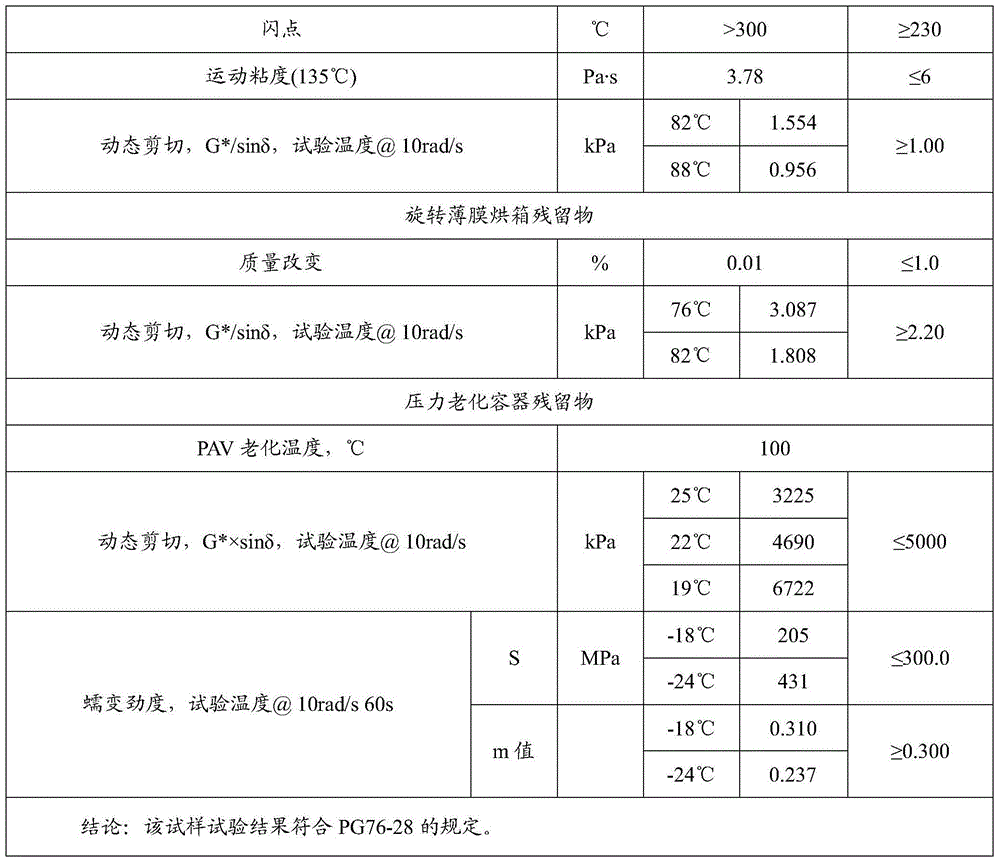A rubber-plastic alloy modified asphalt and asphalt mixture
A rubber-plastic alloy and modified asphalt technology, applied in the field of asphalt processing, can solve the problems of affecting modified asphalt, loss of modification effect, and high cost, and achieve the effects of increasing high temperature strength, improving storage stability and reducing costs.
- Summary
- Abstract
- Description
- Claims
- Application Information
AI Technical Summary
Problems solved by technology
Method used
Image
Examples
Embodiment 1
[0033] A rubber-plastic alloy modified asphalt, the weight of its main components consists of: 13 parts of rubber-plastic alloy modifier, 0.2 part of stabilizer, 80 parts of 70# petroleum asphalt;
[0034] Wherein said stabilizer is sulfur;
[0035] Wherein the rubber-plastic alloy asphalt modifier adopted, its main composition and parts by weight: 65 parts of waste tire rubber powder, 25 parts of waste plastic particles, 2 parts of plasticizer, 0.2 part of surfactant;
[0036] Wherein said waste tire rubber powder is 20 mesh waste radial tire crushed rubber powder; said waste plastic particles are selected from crushed waste plastic particles with a PE component greater than 80wt%; all are purchased directly from the market;
[0037] The plasticizer is selected from epoxy fatty acid methyl ester; the surfactant is selected from FLUORAD FC-430.
[0038] The specific preparation steps are as follows: heating waste tire rubber powder to 230-250° C. on a single-screw machine, ad...
Embodiment 2
[0055] A rubber-plastic alloy modified asphalt, the weight of its main components consists of: 20 parts of rubber-plastic alloy modifier, 1.0 part of stabilizer, 86 parts of 90# petroleum asphalt;
[0056] Wherein said stabilizer is sulfur;
[0057] Wherein the rubber-plastic alloy asphalt modifier adopted, its main composition and parts by weight: 73 parts of waste tire rubber powder, 30 parts of waste plastic particles, 5 parts of plasticizer, 0.6 part of surfactant;
[0058]Wherein said waste tire rubber powder is the crushed rubber powder of 40-mesh waste bias tire; said waste plastic particles are selected from the crushed particles of waste plastics with a PE component greater than 80wt%; all are purchased directly from the market;
[0059] The plasticizer is selected from epoxy fatty acid methyl ester; the surfactant is selected from FLUORADFC-430.
[0060] The specific steps are as follows:
[0061] Heat waste tire rubber powder to 230-250°C on a single-screw machine...
Embodiment 3
[0067] A rubber-plastic alloy modified asphalt, the weight of its main components consists of: 16.6 parts of rubber-plastic alloy modifier, 0.4 part of stabilizer, 83 parts of 70# petroleum asphalt;
[0068] Wherein said stabilizer is sulfur;
[0069] Wherein the rubber-plastic alloy asphalt modifier adopted, its main composition and parts by weight: 72 parts of waste tire rubber powder, 25 parts of waste plastic particles, 2.7 parts of plasticizer, 0.3 part of surfactant;
[0070] Wherein said waste tire rubber powder is the crushed rubber powder of 30 purpose waste radial tires and bias tires; the waste plastic particles are selected from the crushed particles of waste plastics whose PE composition is greater than 80wt%; all from the market purchased directly;
[0071] The plasticizer is selected from epoxy fatty acid methyl ester; the surfactant is selected from FLUORADFC-430.
[0072] The specific steps are as follows:
[0073] Heat waste tire rubber powder to 230-250°C...
PUM
 Login to View More
Login to View More Abstract
Description
Claims
Application Information
 Login to View More
Login to View More - R&D Engineer
- R&D Manager
- IP Professional
- Industry Leading Data Capabilities
- Powerful AI technology
- Patent DNA Extraction
Browse by: Latest US Patents, China's latest patents, Technical Efficacy Thesaurus, Application Domain, Technology Topic, Popular Technical Reports.
© 2024 PatSnap. All rights reserved.Legal|Privacy policy|Modern Slavery Act Transparency Statement|Sitemap|About US| Contact US: help@patsnap.com









